Assessing Heat Waves over Greece Using the Excess Heat Factor (EHF)
Abstract
1. Introduction
2. Materials and Methods
3. Results
3.1. Statistical Analysis and Aspects of the EHF Index
3.2. Examination of the EHF Index in “Capturing” Two Characteristic Heat Waves in Greece
3.2.1. The Heat Wave of the Year 1987
3.2.2. The Heat Wave of the Year 2007
4. Discussion and Conclusions
- It incorporates not only Tmax but also Tmin values which is an important parameter that should be taken under consideration especially if the heat wave study is more human-centered. Temperature rise is undoubtedly related to human health; however, the overnight high temperature impedes the night discharge and results in excess heat stress and an enhancement of the heat wave conditions [1,44,45,46].
- It measures daily temperature values for a three-day period (average) rather than the single temperature of one day, making it more sensitive to temperature changes as it considers also previous day conditions. [1].
- The first term of the EHF (EHIsig) provides a measure of the statistical significance of the heating as it is compared with a fixed percentile value (95th percentile of a defined period which, in this case, was chosen to be 1971–2000).
- The second term (EHIaccl) compares the examined warm conditions with the recent past (previous 30 days) providing an indication of the people’s acclimatization ability to this unusual heat. Conversely to the EHIsig, EHIaccl does not change under a general climate-change warming [12].
- Overall, the application of the EHF can provide information both about the statistical characteristics of a heat wave but also about its effect on humans.
Funding
Conflicts of Interest
References
- Perkins, S.E.; Alexander, L.V. On the Measurement of Heat Waves. J. Clim. 2013, 26, 4500–4517. [Google Scholar] [CrossRef]
- Poumadère, M.; Mays, C.; Le Mer, S.; Blong, R. The 2003 heat wave in France: Dangerous climate change here and now. Risk Anal. 2005, 25, 1483–1494. [Google Scholar] [CrossRef] [PubMed]
- Piticar, A.; Croitoru, A.E.; Ciupertea, F.A.; Harpa, G.V. Recent changes in heatwaves and cold waves detected based on excess heat factor and excess cold factor in Romania. Int. J. Climatol. 2018, 38, 1777–1793. [Google Scholar] [CrossRef]
- Vandentorren, S.; Bretin, P.; Zeghnoun, A.; Mandereau-Bruno, L.; Croisier, A.; Cochet, C.; Ribéron, J.; Siberan, I.; Declercq, B.; Ledrans, M. August 2003 Heat Wave in France: Risk Factors for Death of Elderly People Living at Home. Eur. J. Public Health 2006, 16, 583–591. [Google Scholar] [CrossRef] [PubMed]
- Díaz, J.; Jordán, A.; García, R.; López, C.; Alberdi, J.; Hernández, E.; Otero, A. Heat waves in Madrid 1986–1997: Effects on the health of the elderly. Int. Arch. Occup. Environ. Health 2002, 75, 163–170. [Google Scholar] [CrossRef] [PubMed]
- Barnett, A.G.; Hajat, S.; Gasparrini, A.; Rocklov, J. Cold and heat waves in the United States. Environ. Res. 2012, 112, 218–224. [Google Scholar] [CrossRef] [PubMed]
- D’Ippoliti, D.; Michelozzi, P.; Marino, C.; De’Donato, F.; Menne, B.; Katsouyanni, K.; Kirchmayer, U.; Analitis, A.; Medina-Ramón, M.; Paldy, A.; et al. The impact of heat waves on mortality in 9 European cities: Results from the EuroHEAT project. Environ. Health 2010, 9, 37. [Google Scholar] [CrossRef]
- Baccini, M.; Biggeri, A.; Accetta, G.; Kosatsky, T.; Katsouyanni, K.; Analitis, A.; Anderson, H.R.; Bisanti, L.; D’ippoliti, D.; Danova, J.; et al. Heat Effects on Mortality in 15 European Cities. Epidemiology 2008, 19, 711–719. [Google Scholar] [CrossRef]
- EM-DAT. The International Disaster Database: Center for Research on the Epidemiology of Disasters—CRED. Available online: https://www.emdat.be/ (accessed on 7 January 2019).
- Langlois, N.; Mason, K.; Nairn, J.; Roger, W. Using the Excess Heat Factor (EHF) to predict the risk of heat related deaths. J. Forensic Legal Med. 2013, 20, 408–411. [Google Scholar] [CrossRef]
- Smith, T.T.; Zaitchik, B.F.; Gohlke, J.M. Heat waves in the United States: Definitions, patterns and trends. Clim. Chang. 2013, 118, 811–825. [Google Scholar] [CrossRef]
- Nairn, J.; Fawcett, R. The excess heat factor: A metric for heatwave intensity and its use in classifying heatwave severity. J. Environ. Res. Public Health 2015, 12, 227–253. [Google Scholar] [CrossRef] [PubMed]
- Smouer-Tomic, K.E.; Kuhn, R.; Hudsonh, A. Heat wave hazards: An overview of Heat Wave impacts in Canada. Nat. Hazards 2003, 28, 463–485. [Google Scholar]
- Matzarakis, A.; Mayer, H.; Iziomon, M. Applications of a universal thermal index: Physiological equivalent temperature. Int. J. Biometeorol. 1999, 43, 76–84. [Google Scholar] [CrossRef] [PubMed]
- Matzarakis, A.; De Rocco, M.; Najjar, G. Thermal bioclimate in Strasbourg—The 2003 heat wave. Theor. Appl. Climatol. 2009, 98, 209–220. [Google Scholar] [CrossRef]
- Matzarakis, A.; Nastos, P.T. Human-biometeorological assessment of heat waves in Athens. Theor. Appl. Climatol. 2011, 105, 99–106. [Google Scholar] [CrossRef]
- Nastos, P.T.; Matzarakis, A. The effect of air temperature and human thermal indices on mortality in Athens, Greece. Theor. Appl. Climatol. 2012, 108, 591–599. [Google Scholar] [CrossRef]
- WMO; WHO. Heatwaves and Health Guidance on Warming-System Development. Available online: https://public.wmo.int/en/projects (accessed on 29 December 2018).
- Meehl, G.A.; Tebaldi, C. More Intense, More Frequent, and Longer Lasting Heat Waves in the 21st Century. Science 2004, 305, 994–997. [Google Scholar] [CrossRef]
- IPCC. Managing the risks of extreme events and disasters to advance climate change adaptation. In A Special Report of Working Groups I and II of the Intergovernmental Panel on Climate Change; Field, C.B., Barros, V., Stocker, T.F., Qin, D., Dokken, D.J., Ebi, K.L., Mastrandrea, M.D., Mach, K.J., Plattner, G.-K., Allen, S.K., et al., Eds.; Cambridge University Press: Cambridge, UK; New York, NY, USA, 2012; 582p. [Google Scholar]
- Xoplaki, E.; Gonzalez-Rouco, J.F.; Luterbacher, J.; Wanner, H. Mediterranean summer air temperature variability and its connection to the large-scale atmospheric circulation and SSTs. Clim. Dyn. 2003, 20, 723–739. [Google Scholar] [CrossRef]
- Kostopoulou, E.; Jones, P.D. Assessment of climate extremes in the eastern Mediterranean. Meteorol. Atmos. Phys. 2005, 89, 69–85. [Google Scholar] [CrossRef]
- Della-Marta, P.M.; Haylock, M.R.; Luterbacher, J.; Wanner, H. Doubled length of western European summer heat waves since 1880. J. Geophys. Res. 2007, 112, D15103. [Google Scholar] [CrossRef]
- Tolika, K.; Maheras, P.; Tegoulias, I. Extreme temperatures in Greece during 2007. Could this be a “return to the future”? Geophys. Res. Lett. 2009, 36. [Google Scholar] [CrossRef]
- Ouzeau, G.; Soubeyroux, J.-M.; Schneider, M.; Vautard, R.; Planton, S. Heat waves analysis over France in present and future climate: Application of a new method on the EURO-CORDEX ensemble. Clim. Serv. 2016, 4, 1–12. [Google Scholar] [CrossRef]
- Salata, F.; Golasi, I.; Petitti, D.; de Lieto Vollaro, E.; Coppi, M.; de Lieto Vollaro, A. Relating microclimate, human thermal comfort and health during heat waves: An analysis of heat island mitigation strategies through a case study in an urban outdoor environment. Sustain. Cities Soc. 2017, 30, 79–96. [Google Scholar] [CrossRef]
- Roldán, E.; Gómez, M.; Pino, M.R.; Pórtoles, J.; Linares, C.; Díaz, J. The effect of climate-change-related heat waves on mortality in Spain: Uncertainties in health on a local scale. Stoch. Environ. Res. Risk Assess. 2016, 30, 831–839. [Google Scholar] [CrossRef]
- Miron, I.J.; Linares, C.; Montero, J.C.; Criado-Alvarez, J.J.; Díaz, J. Changes in cause-specific mortality during heat waves in central Spain, 1975–2008. Int. J. Biometeorol. 2015, 59, 1213–1222. [Google Scholar] [CrossRef]
- Prezerakos, N. A contribution to the study of the extreme heat wave over the South Balkans in July 1987. Meteorol. Atmos. Phys. 1989, 41, 261–271. [Google Scholar] [CrossRef]
- Matzarakis, A.; Mayer, H. The extreme heat wave in Athens in July 1987 from the point of view of human biometeorology. Atmos. Environ. 1991, 25, 203–211. [Google Scholar] [CrossRef]
- Giles, B.D.; Balafoutis, C.J. The Greek heatwaves of 1987 and 1988. Int. J. Climatol. 1990, 10, 505–517. [Google Scholar] [CrossRef]
- Balafoutis, C.; Makrogiannis, T. Analysis of a heat wave phenomenon over Greece and it’s implications for tourism and recreation. In Proceedings of the First International Workshop o2n Climate, Tourism and Recreation, Halkidiki, Greece, 5–10 October 2001; pp. 113–121. [Google Scholar]
- Founda, D.; Giannakopoulos, C. The exceptionally hot summer of 2007 in Athens, Greece—A typical summer in the future climate? Glob. Plan. Chang. 2009, 67, 227–236. [Google Scholar] [CrossRef]
- Nairn, J.; Fawcett, R.; Ray, D. Defining and predicting excessive heat events: A national system. In Proceedings of the Modelling and Understanding High Impact Weather: Extended Abstracts of the Third CAWCR Modelling Workshop, Melbourne, Australia, 30 November–2 December 2009; Volume 17, pp. 83–86. [Google Scholar]
- Urban, A.; Hanzlíková, H.; Kyselý, J.; Plavcová, E. Impacts of the 2015 heat waves on mortality in the Czech Republic—A comparison with previous heat waves. Int. J. Environ. Res. Public Health 2017, 14, 1562. [Google Scholar] [CrossRef]
- Trigo, R.; Garia-Herrera, R.; Diaz, J.; Trigo, I.; Valente, M. How exceptional was the early August 2003 heatwave in France? Geophys. Res. Lett. 2005, 32, L10701. [Google Scholar] [CrossRef]
- Karl, T.R.; Knight, R.W. The 1995 Chicago Heat Wave: How likely is a recurrence? Bull. Am. Meteorol. Soc. 1997, 78, 1107–1120. [Google Scholar] [CrossRef]
- Alexandersson, H. A homogeneity test applied to precipitation data. J. Climatol. 1986, 6, 661–675. [Google Scholar] [CrossRef]
- Sneyers, R. Sur L’analyse Statistique des Series D’observations; OMM Publ. No. 415. Note Technique 143; OMM: Geneve, Switzerland, 1975; 192p. [Google Scholar]
- Berz, G. List of Major Natural Disasters, 1960–1987. Nat. Hazards 1998, 1, 97–99. [Google Scholar] [CrossRef]
- Giles, B.D.; Balafoutis, C.; Maheras, P. Too hot for comfort: The heatwaves in Greece in 1987 and 1988. Int. J. Biometeorol. 1990, 34, 98–104. [Google Scholar] [CrossRef] [PubMed]
- Theoharatos, G.; Pantavou, K.; Spanou, A.; Katavoutas, G.; Makrygiannis, G.; Mavrakis, A. Discomfort index levels during the heatwaves of June and July 2007 in Greece. In Proceedings of the 11th International Conference on Environmental Science and Technology, Chania, Greece, 3–5 September 2009; pp. 946–952. [Google Scholar]
- Katavoutas, G.; Theoharatos, G.; Flocas, H.A.; Asimakopoulos, D.N. Measuring the effects of heat wave episodes on the human body’s thermal balance. Int. J. Biometeorol. 2009, 53, 177–187. [Google Scholar] [CrossRef] [PubMed]
- Pattendend, S.; Nikiforov, B.; Armstrong, B.G. Mortality and temperature in Sofia and London. Epidemiol. Community Health 2003, 57, 628–633. [Google Scholar] [CrossRef]
- Pirard, P.; Vandentorren, S.; Pascal, M.; Laaidi, K.; Le Tertre, A.; Cassadou, S.; Ledrans, M. Summary of the mortality impact assessment of the 2003 heat wave in France. Eurosurveillance 2005, 10, 153–156. [Google Scholar] [CrossRef] [PubMed]
- Nicholls, N.; Skinner, C.; Loughnan, M.; Tapper, N. A simple heat alert system for Melbourne, Australia. Int. J. Biometeorol. 2008, 52, 375–384. [Google Scholar] [CrossRef]
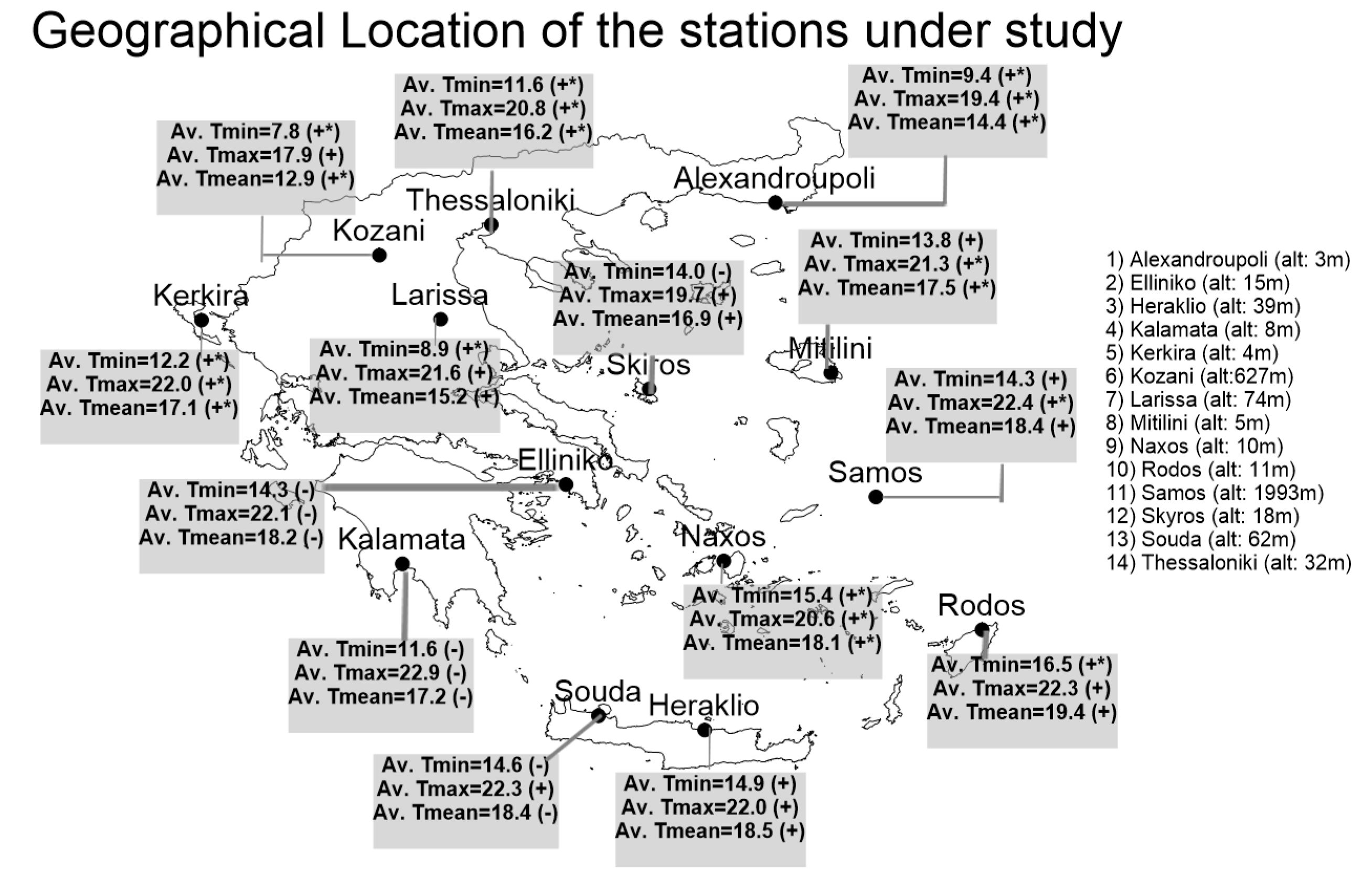
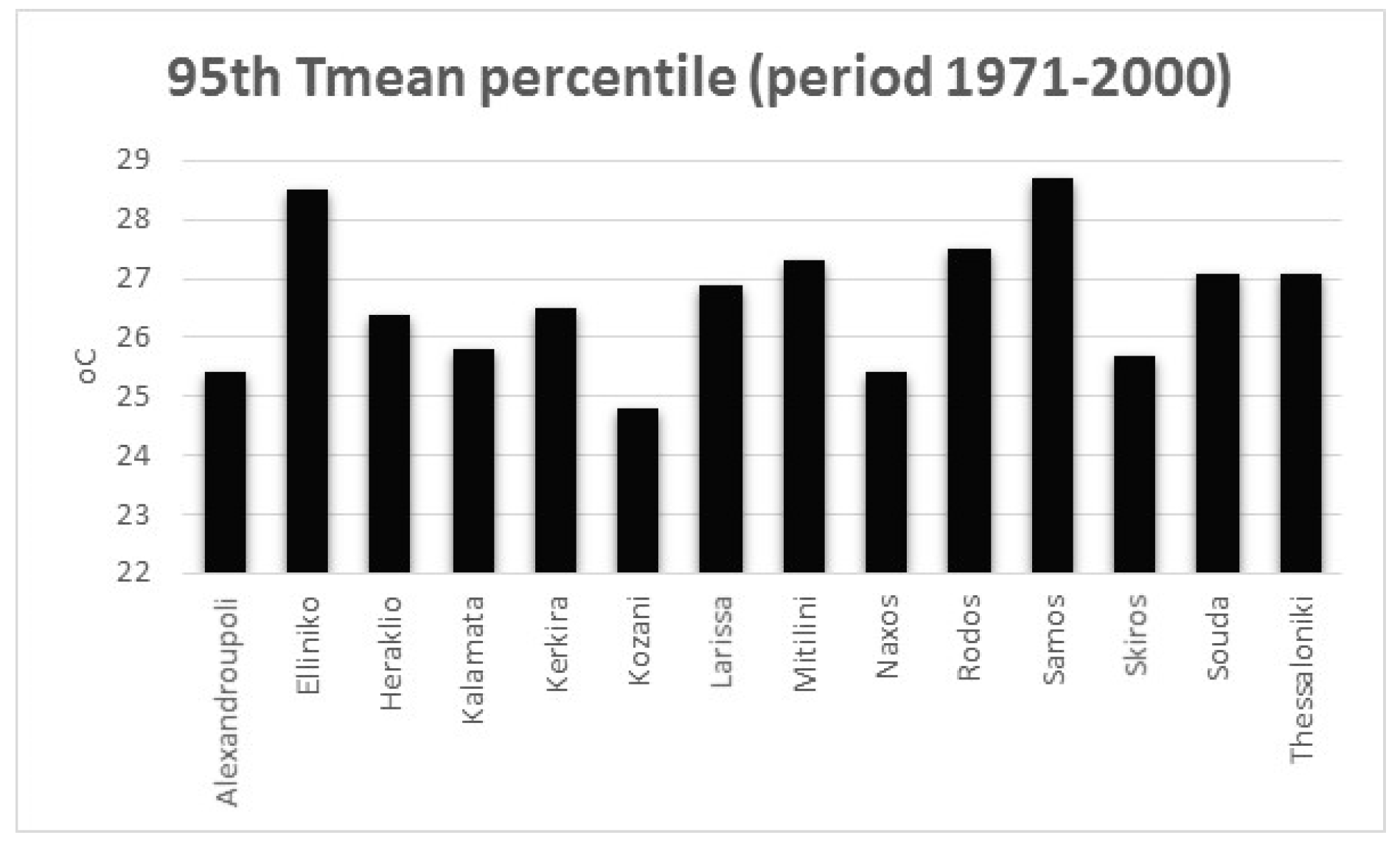
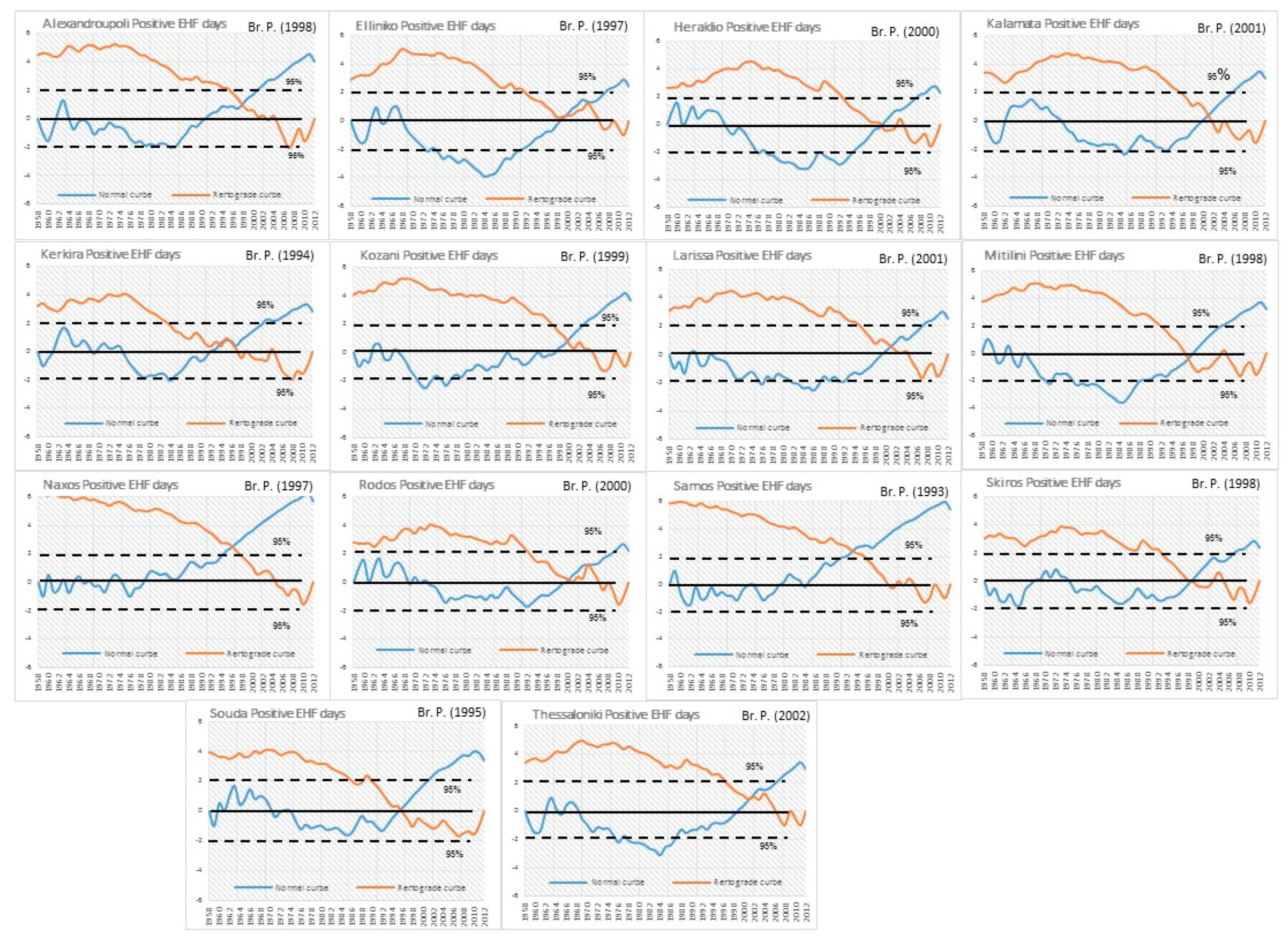
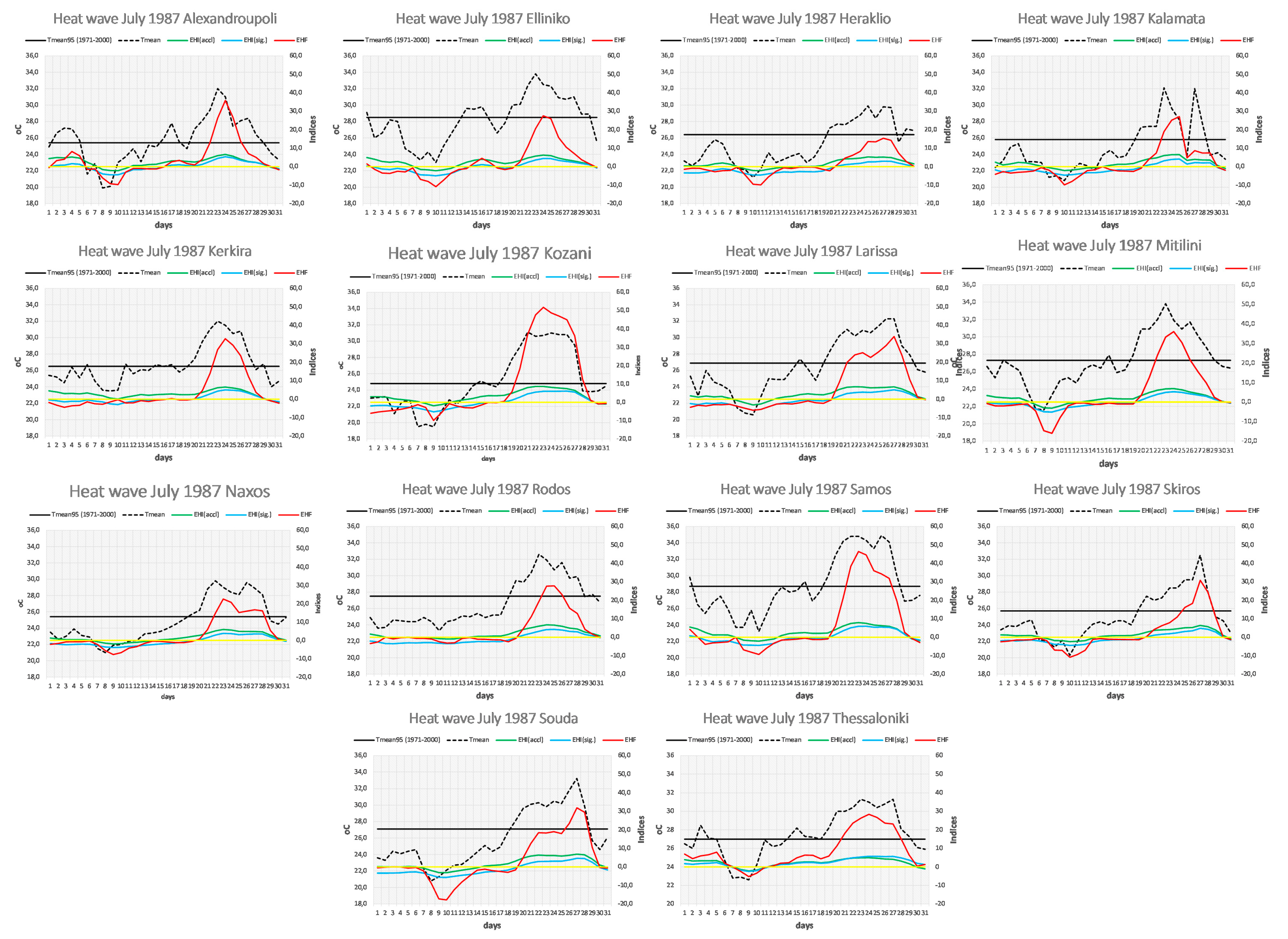
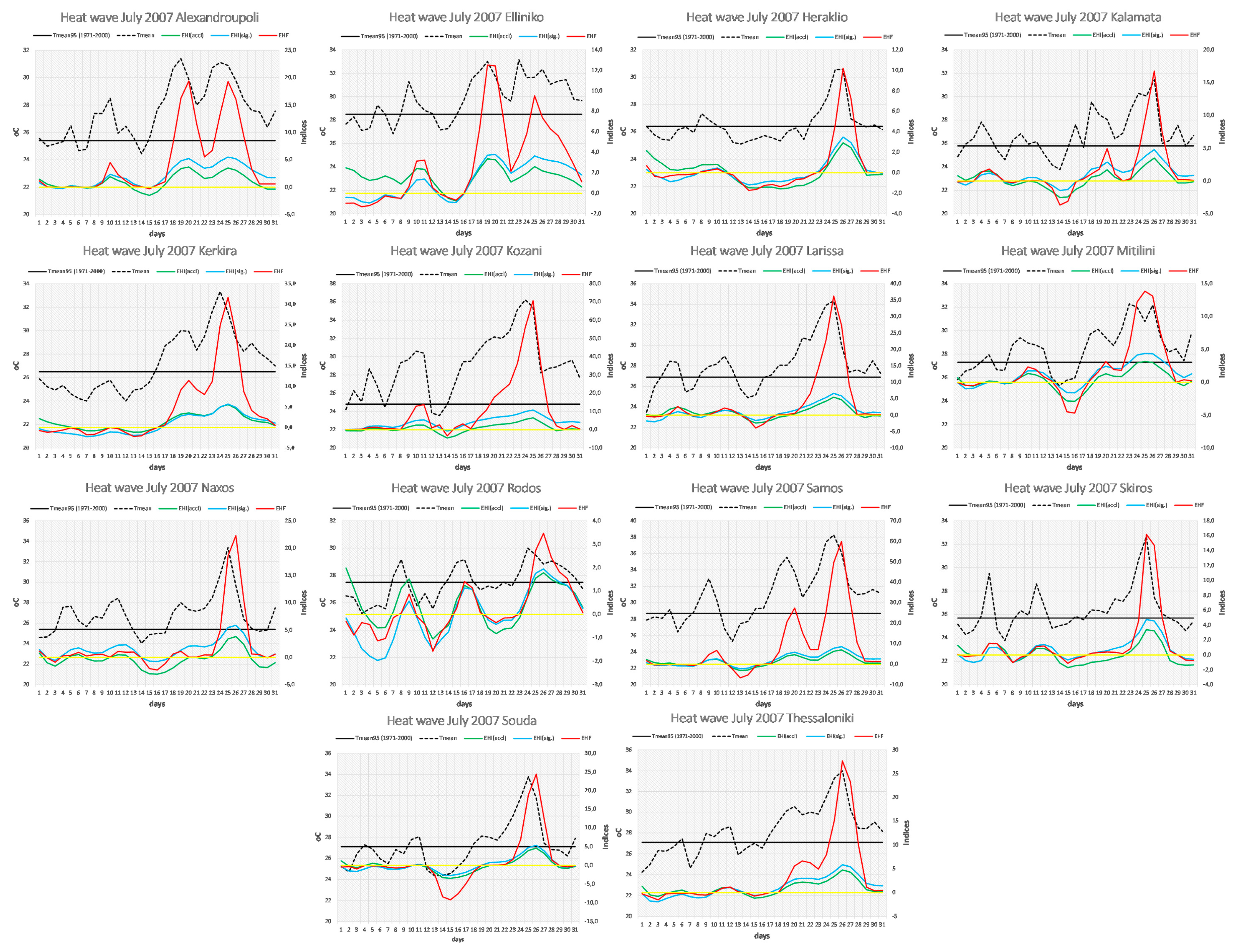
| Average Positive EHF Days | Max. Positive EHF Days | Trend Positive EHF Days | |
|---|---|---|---|
| Alexandroupoli | 23.0 | 72 (2012) | +0.76 |
| Elliniko | 21.7 | 76 (2011) | +0.41 |
| Heraklio | 18.5 | 51 (2010) | +0.41 |
| Kalamata | 22.8 | 80 (2012) | +0.65 |
| Kerkira | 21.5 | 71 (2012) | +0.56 |
| Kozani | 23.9 | 77 (2008) | +0.79 |
| Larissa | 17.9 | 56 (2012) | +0.44 |
| Mitilini | 21.0 | 63 (2007) | +0.63 |
| Naxos | 22.8 | 89 (2010) | +1.14 |
| Rodos | 19.4 | 50 (2012) | +0.34 |
| Samos | 21.0 | 67 (2012) | +0.89 |
| Skiros | 19.5 | 52 (2007) | +0.41 |
| Souda | 17.9 | 49 (2012) | +0.45 |
| Thessaloniki | 21.9 | 63 (2012) | +0.58 |
| 3–10 Days | 11–20 Days | 21–30 Days | >30 Days | Maximum Spell Duration | |
|---|---|---|---|---|---|
| Alexandroupoli | 106 | 26 | 5 | 4 | 45 days (2012) |
| Elliniko | 127 | 26 | 2 | 1 | 37 days (2011) |
| Heraklio | 119 | 21 | 1 | 0 | 30 days (2010) |
| Kalamata | 146 | 20 | 2 | 2 | 57 days (2012) |
| Kerkira | 105 | 23 | 3 | 5 | 58 days (2012) |
| Kozani | 140 | 23 | 5 | 1 | 32 days (2008) |
| Larissa | 117 | 15 | 3 | 0 | 28 days (2012) |
| Mitilini | 116 | 20 | 7 | 1 | 32 days (2011) |
| Naxos | 106 | 19 | 2 | 7 | 57 days (2010) |
| Rodos | 130 | 20 | 0 | 1 | 33 days (2012) |
| Samos | 124 | 19 | 5 | 1 | 39 days (2012) |
| Skiros | 134 | 18 | 2 | 0 | 25 days (2010) |
| Souda | 132 | 15 | 0 | 0 | 18 days (1999) |
| Thessaloniki | 116 | 22 | 5 | 1 | 38 days (2012) |
© 2019 by the author. Licensee MDPI, Basel, Switzerland. This article is an open access article distributed under the terms and conditions of the Creative Commons Attribution (CC BY) license (http://creativecommons.org/licenses/by/4.0/).
Share and Cite
Tolika, K. Assessing Heat Waves over Greece Using the Excess Heat Factor (EHF). Climate 2019, 7, 9. https://doi.org/10.3390/cli7010009
Tolika K. Assessing Heat Waves over Greece Using the Excess Heat Factor (EHF). Climate. 2019; 7(1):9. https://doi.org/10.3390/cli7010009
Chicago/Turabian StyleTolika, Konstantia. 2019. "Assessing Heat Waves over Greece Using the Excess Heat Factor (EHF)" Climate 7, no. 1: 9. https://doi.org/10.3390/cli7010009
APA StyleTolika, K. (2019). Assessing Heat Waves over Greece Using the Excess Heat Factor (EHF). Climate, 7(1), 9. https://doi.org/10.3390/cli7010009




